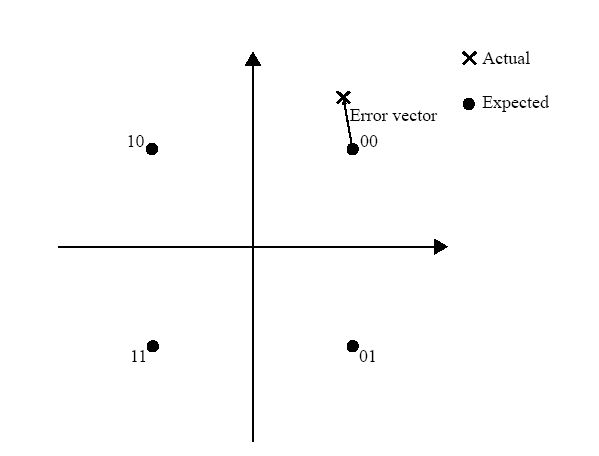Without understanding radio level impairments, one can’t fully appreciate the Wi-Fi PHY layer.
Basically, the job of PHY layer (or radio) is to convert digital bits into a radio frequency (RF) waveform and vice-versa. The amount of distortion in a Wi-Fi frame is measured by a metric called error vector magnitude (EVM). EVM encompasses all forms of distortion or added noise. EVM for a signal is defined as the root mean square (RMS) average magnitude of the error vector normalized to the ideal signal amplitude. The error vector refers to the vector between the actual constellation point as seen by a receiver and the ideal constellation point. An intuitive way to interpret EVM is simply (1/SNR) ; i.e., in dB scale EVM(dB) = -SNR(dB). If we measure SNR directly at any radio transmitter, it is difficult to get more than 40 dB, when ideally it should be infinity.
Radio impairments are the main cause for distortion in a radio implementation. Why does it happen? Physics of analog world, part-to-part variations, manufacturing tolerance of components, variations in temperature/voltage. Common radio impairments are:
-
Rx DC offset: Introduced by baseband amplification stages and carrier leakage inside the mixer of frequency down conversion circuitry. Reduces ADC dynamic range and Rx performance.
-
IQ mismatch: Caused by phase and gain imbalance between the in-phase and quadrature-phase analog baseband circuitry. Distorts both Tx and Rx signals.
-
Tx carrier leak: Caused by carrier leakage inside mixer which gets amplified by the PA. Wastes transmitted energy and makes it harder for receivers to detect Wi-Fi frames.
-
Phase noise: Caused by crystal oscillator, RF synthesizer. Distorts both Tx and Rx signals.
-
Power Amplifier ¶ nonlinearity: Caused by nonlinear transfer function of PA, characterized by the 1 dB compression point of PA. Since OFDM has high peak-to-average power ratio (PAPR), PA nonlinearity usually limits the maximum Tx power for higher-order modulations (64-QAM+). PA nonlinearity also creates side lobe emissions causing interference to Wi-Fi devices on adjacent channel.
Overcoming Radio Impairments:
Modern radio implementations mitigate radio impairments by performing radio calibration, that involves measuring the amount of radio impairment and compensating for it either in the digital baseband or in the analog domain. For example, Rx DC offset and Tx carrier leak can be compensated by adding a DC signal of equal magnitude but opposite polarity to the signal. Similarly, predistorting the signal with the PA’s inverse transfer function before feeding it to the PA can mitigate PA nonlinearity. The radio calibration data containing the compensation values is measured across various channel frequencies, Tx and Rx amplifier gain settings, temperature, and stored in local memory which gets applied at runtime.

Credits: ![]()